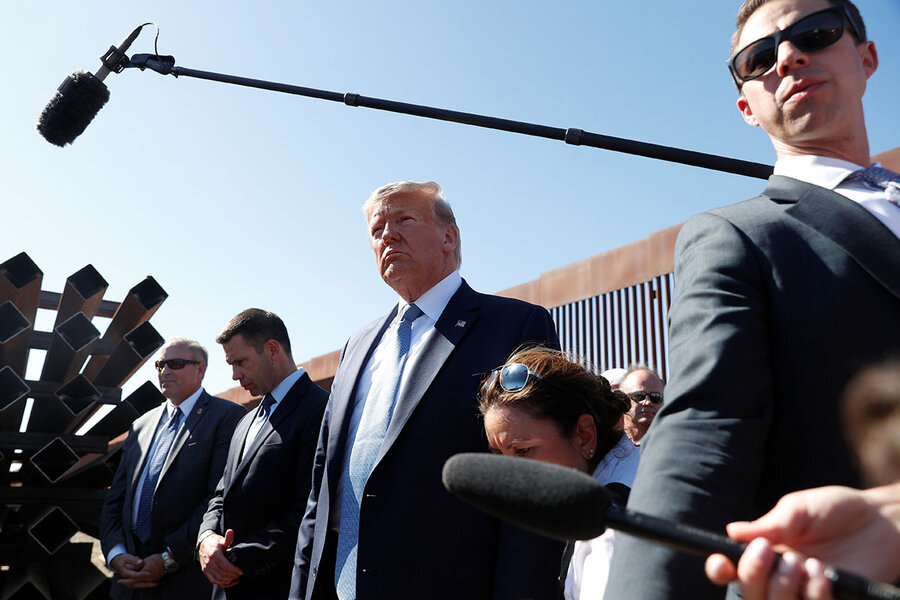What happens when a president feuds with nation’s largest state?
Loading...
| Pasadena, Calif.
It has become a battle royal: the leader of the world’s largest economy versus the leaders of the fifth largest, with little incentive for a cease-fire.
We are talking, of course, about President Donald Trump and California. Last week, the president combined a visit for campaign cash with a mighty strike at the blue state – revoking the state’s decadeslong ability to set its own tough auto emissions standards. He also castigated its cities for “allowing” the homeless crisis, warning San Francisco that it’s violating environmental rules over the issue.
Democratic Gov. Gavin Newsom and other leaders are fighting back. On Friday, California, along with 22 other states and several major cities, filed a lawsuit against the administration’s emissions action – its 60th suit against the administration. On Monday, the governor spoke at the United Nations climate action summit, touting California’s leadership in the switch to clean energy, with such jobs outnumbering those in the fossil fuel industry 5 to 1, and California outpacing U.S. economic growth.
Why We Wrote This
The rift between the White House and California has become a chasm, raising questions about the future of states’ rights and whether the tension will harm the nation’s largest state.
“I don’t know what the hell happened to this country that we have the president that we do today on this issue,” he said, adding that President Trump is turning the conservative argument of states’ rights on its head. A serious problem with smog led to a waiver for the state to set its own tailpipe standards under the Clean Air Act, signed by a Republican president (Richard Nixon) while a Republican governor (Ronald Reagan) was in office.
The widespread feeling here is that the president feels snubbed by four automakers that agreed to California’s standards. He won one last week, though, when a federal judge blocked a new California law requiring disclosure of tax returns to qualify for the presidential primary ballot.
“I’ve never seen the animus so strong,” says longtime political observer Barbara O’Connor, speaking of the combat between Sacramento and Washington. And it’s not limited to those two capitals, she says. “It has huge ripple effects” across the country, with the potential to turn red states like Arizona against the president.
“The ripple is coming. It’s based on clean air and water and the Constitution, and whether or not there are really three [branches] of government in Washington,” she says. San Francisco and Los Angeles are hardly alone in having to deal with homelessness, though their challenge is severe, and voters are also impatient with the slow pace of various lawsuits against the administration, according to Professor O’Connor.
“I see it as ultimately playing out as political change,” she says.
Not all observers see such far-reaching reverberations.
“I don’t think there’s much effect in the great beyond,” says Bill Whalen, former speechwriter to Pete Wilson, California’s Republican governor during the 1990s.
President Trump’s criticism of California liberals goes back to his campaign, illustrated by his focus on the 2015 killing of Kate Steinle by a convicted felon who was in the country illegally, says Mr. Whalen. “It really hasn’t changed.”
Terry Madonna, a pollster in the swing state of Pennsylvania, doesn’t think the ongoing fight sways voters “one way or the other.” Their opinions of the president are hardened, and most of his supporters likely share his views of liberal California.
But here’s where observers align: The last time a governor of California and a president of the other party were at serious loggerheads, the conflict was not nearly as personal or partisan. When former Governor Wilson and then-President Bill Clinton locked horns over immigration, the Wilson team published Op-Eds and ran ads in The New York Times, recalls Mr. Whalen, who is now a fellow at the Hoover Institution. “That was nothing compared to the vitriol here.”
And yet there is no incentive for either side to disarm, he explains.
For President Trump, California is a convenient foil in a race that will be won or lost in the Midwest. He has no hope of winning in a state where he is wildly unpopular, but he can point to California as liberalism run amok – on immigration, homelessness, and income disparity. He has made not only the governor, but the entire Democratic establishment his punching bag, from mayors to members of Congress.
Neither is it in the interest of the governor to stand down.
Governor Newsom is in a strong position to fight the Trump administration because California is running historic budget surpluses. He can rely on a fellow Californian, House Speaker Nancy Pelosi, to defend the breach in Washington. Ms. Pelosi was expected to announce a formal impeachment inquiry Tuesday against President Trump. Governor Newsom, meanwhile, has political ambition and a role to promote as a leader of the “resistance” to the president – and perhaps as a potential presidential candidate down the road.
But the governor says that values and the future are at stake when it comes to climate change. “I know ... we’re supposed to stay above politics, but you can’t on this issue,” he told the summit audience on Monday. Given the state’s recent experience with fires, floods, and drought, “this is not an intellectual exercise for us.”
It can be argued that the battle over auto emissions could have a ripple effect – given that 13 other states, plus Washington, D.C., follow California’s standards and account for about a third of the U.S. auto market. Yet the four automakers say they are sticking with California. The staying power of the conflict may also hinge on who wins the 2020 presidential election.
Much more could be accomplished if the president and California worked together, says John Pitney, professor of political science at Claremont McKenna College in California. But he does not think the state will pay a high price in the end.
“We’ll muddle through,” he says. “That’s the beauty of the separation of powers. California can make its plea to the House. It can make its appeal to the courts. It’s not an ideal situation, but the ideal is the exception, rather than the rule.”







